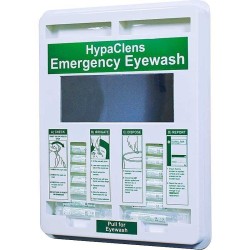Eyewash Bottles and Pods
There are 2 products.
Active filters
About Eyewash Bottles and Pods
Portable Emergency Eye Irrigation for Immediate Response
Eyewash bottles and pods provide portable emergency eye irrigation solutions enabling immediate eye washing following chemical splashes, dust exposure, or contamination across workplaces, construction sites, mobile services, and varied environments throughout England, Scotland, Wales, and Northern Ireland. These convenient portable devices contain sterile saline or water for immediate eye irrigation, offering flexible emergency response capability where fixed eyewash stations are impractical. Organisations rely on eyewash bottles and pods for immediate portable eye irrigation, flexible emergency response in varied locations, supplementary provision near minor hazards, mobile work safety, and accessible first aid eye care. Modern eyewash bottles and pods incorporate features including sterile isotonic saline solutions, portable convenient sizes, integrated eye cups facilitating effective irrigation, clear instructions, and sealed packaging ensuring sterility until use. The provision of eyewash bottles and pods demonstrates commitment to comprehensive eye safety, supports immediate irrigation capability across varied locations, enables flexible emergency response, and fulfils duty of care across environments with eye contamination risks.
The implementation of eyewash bottles and pods supports flexible eye safety provision, immediate irrigation capability, and comprehensive emergency preparedness across varied locations. Whilst fixed eyewash stations provide optimal sustained irrigation for chemical splash scenarios, portable eyewash enables immediate response in varied locations and addresses less severe contamination. Eyewash bottles and pods address these needs by providing immediate portable irrigation capability, flexible provision for mobile work or multiple locations, appropriate response for dust or minor contamination, supplementary provision enhancing fixed station capability, and convenient first aid eye irrigation. Applications include construction sites requiring mobile eye safety provision, field work away from fixed facilities, workshops and maintenance areas with dust hazards, mobile services including emergency response and utilities, and first aid kits requiring eye irrigation capability. Organisations benefit from eyewash bottles and pods through flexible eye safety provision, immediate response capability across varied locations, cost-effective supplementary provision, and comprehensive eye injury preparedness. Modern eyewash products incorporate features such as ergonomic bottle designs, extended shelf life, and portable carrying options throughout England, Scotland, Wales, and Northern Ireland.
Selecting and implementing eyewash bottles and pods requires assessment of eye hazard locations, appropriate product specification, and integration with eye safety protocols across organisations throughout the UK. Safety managers should evaluate eye hazard distribution determining where portable provision is appropriate versus fixed stations, assess typical contamination scenarios, consider mobile or dispersed work requiring portable safety provision, and calculate adequate quantities. Product selection should prioritise sterile saline solutions providing appropriate irrigation, adequate volumes typically 500ml minimum, integrated eye cups or nozzles facilitating effective use, portable convenient packaging, and appropriate shelf life. Implementation protocols should encompass strategic placement in first aid kits and work areas, integration with eyewash station provision where applicable, staff training on eyewash use, eye injury emergency procedures, and documented supply management. Quality assurance measures should include regular supply checks, expiry date monitoring replacing solutions as needed, restocking procedures, and incident recording. Modern eyewash supply management may incorporate inventory tracking and automated reordering. Organisations should establish eye injury procedures differentiating scenarios requiring sustained irrigation via stations versus portable eyewash sufficiency, integrate eyewash provision with broader eye safety management, and maintain documentation. Staff education should address eyewash bottle locations and use, immediate irrigation importance, sustained washing for chemical splashes, and emergency services notification for serious injuries. Storage should protect eyewash supplies whilst ensuring accessibility. By implementing eyewash bottles and pods alongside appropriate protocols, organisations throughout England, Scotland, Wales, and Northern Ireland demonstrate commitment to comprehensive eye safety across varied locations, flexible emergency response capability, immediate irrigation provision, and professional eye injury management supporting optimal outcomes through accessible appropriate treatment across all working environments with eye contamination risks.


